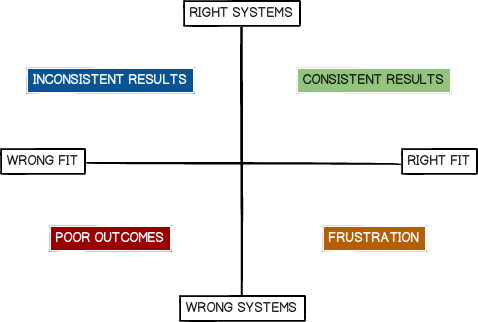Let’s face it. The way we manage churches usually makes absolutely no sense whatsoever to the outside world. And before we quickly write off this statement with a “well, that’s because churches shouldn’t be businesses,” consider this.
You can have a structure that works, but isn’t biblical. That’s bad. Some examples?
- Having powerful marketing machinery but no discipleship process.
- Firing people over inefficiency with no concern for their soul or their family.
- Prioritizing results over relationships and numerical growth over spiritual health.
You can also have a structure that seems biblical, but doesn’t really work. For example…
- Worship that honors traditional liturgical approaches but makes no sense to outsiders.
- Giving everyone an equal voice in every decision the church makes.
- Keeping leaders under control so they don’t do anything that scares anyone.
I spent a lot of years serving wonderful people in wonderful church families that had a poor and unhealthy structure. And I was partly to blame for not getting to the root of our issues, or knowing what to do and not having the guts to make people uncomfortable enough to change the status quo.
Now that I’m serving a newer church plant (we’re currently just over four years old), things work very differently because we’ve been able to organize and manage our growth in ways that are both biblical and effective. What surprises many people who come from traditional churches is that we don’t have any committees or business meetings. The congregation has never voted on anything, and won’t until we get ready to buy land, build a building, or hire a new Lead Pastor.
You may assume that we have, then, either a dictatorship or all out chaos. But to clarify, we also don’t have power struggles, fights over the death of traditions, or clamoring for positions of influence. I wrote about a similar subject recently and someone on Facebook asked a great question.
How do you get things done without voting on anything?
I’d like to answer the question, but I’d also like to expand on it. The problem isn’t voting, or not voting, necessarily, even though I did write about 19 reasons Baptist should just stop voting on stuff. The problem is a faulty ecclesiology that assumes a democratic form of church polity – an Americanized, or at least westernized take on the New Testament. And it’s also a psychological problem. We fear losing our share of the control as a group grows, so we create structures to keep it small.
So… how do you create and sustain a biblical, healthy church structure that enables a church to move forward without the red tape of committees and business meetings? Here are at least five things I’ve seen working well.
1. Create a healthy, unified culture.
Peter Drucker famously said, “Culture eats strategy for breakfast.” True. Here’s what that means for pastors and church leaders…
You can attend conferences, read books, write vision statements, preach missional messages, offer training, and pass along all the rules and policies your heart desires. But you won’t see forward momentum until you create a healthy culture.
And how do you create a healthy, positive, visionary, forward-leaning culture within a congregation? You write out your core values, make sure they’re framed positively with a bent toward action, boil them down to six or eight phrases, and then repeat those phrases over and over to your staff, your leaders, your church, and your community.
In other words, as the leader, you model a this is who we are set of core values as you lead, preach, relate to people, and make decisions.
Most of the long term attenders at Grace Hills can tell you something like…
We’re a church that welcomes everybody, that’s heavy on grace and light on judgment, where everybody matters, everybody belongs, and everybody has a part to play. We’re flexible. There are no sacred cows. This is who we are.
Why is that? Because we’ve based our core values in the content of the New Testament, we’ve articulated them and repeated them, and we’ve lived by them consistently.
2. Fight FOR people rather than fighting against them.
You’re the leader, right? So don’t be a baby, or a whiner, or a fit-thrower, or a conniver, or a manipulator. Be mature. Be positive. Be visionary. Paint a bright picture of the future. Value and listen to everyone. And refuse to get into a firefight.
Too many Pastors have chosen hills to die on that weren’t worth people getting hurt over in the first place. Pick your battles, and try to do everything you can not to let it become a battle. Do everything you can to stave off walk-out’s, uprisings, splits, and schisms.
Obviously, sometimes this is beyond your control as the leader. Sometimes you inherit a fight. But as much as is in your power, be intentional about what culture you’re not going to create. It’s important to remind people of the culture you’re trying to create with both a this is who we ARE as well as a this is NOT who we are… now put down the rocks...
3. Teach leadership, and set leaders free.
The Bible has a TON to say about good leadership. It’s filled with stories of great leaders, mediocre leaders, and terrible leaders. There are also proverbs and principles sprinkled throughout the wisdom literature of Scripture. And then there is the amazingly effective leadership approach of Jesus, and later, his well-trained and Spirit-filled apostles.
So look to the Bible as the basis for structuring your church. Point out Acts 20, 1 Timothy 3, 1 Peter 5 and other passages that spell out the leadership responsibilities of Pastors (which is twofold: to lead and to feed the flock). Teach what Ephesians 4 has to say about Pastors being equippers of leaders who carry out the ministry as a healthy body. Remind the congregation of Acts 6, where great leaders were hand-selected to take ownership of major areas of ministry.
At some point, you may need to re-write your church’s by-laws and articulate publicly and in writing your intended leadership structure. (Here’s a link to a page on Grace Hills’ site where you can find our versions of these documents, and more.)
4. Make decisions at the lowest possible level.
Every church body needs to have a clear understanding that leaders are empowered to lead with confidence, not to constantly beg for permission. The ability to make decisions should be handed down to the lowest possible level. If you’re unfamiliar with this organizational style, let me illustrate with some examples…
- The youth leader should be able to plan an event and order pizza without having to call a meeting with a youth committee.
- The maintenance leader should be able to replace or upgrade broken equipment without waiting for next month’s business meeting and an hour long church-wide discussion and vote.
- The preschool leader should be able to make a preschool classroom look amazing to preschoolers without the feedback or approval of a committee of people who don’t even volunteer to help lead the preschool class.
I love it when leaders and volunteers ask me the question, as the Lead Pastor, what do you want us to do next? Most of the time the next words that come out of my mouth are what do YOU think we should do next? See how empowering that is? To grant freedom? To invite people to create, to dream, to have a vision and pursue it is one of the greatest blessings you can have as a Pastor.
So cut the red tape. Stop making people feel afraid that they’re going to be scrutinized, shut down, cut off, or removed from leadership over preferences and issues that should never have been discussed by a bunch of people with no vested interest in the particular issue at hand.
5. Be transparent and protect the integrity of the organization.
If we stop having business meetings and votes and committees, won’t people get suspicious and fearful? Possibly. And that’s why you need to work extra hard to build trust, which is the currency of all effective leadership.
The more often you make good, wise, biblically-informed, Spirit-filled, and elder-blessed decisions that produce fruit and positive results, the more people will trust and follow your leadership. And the more transparent you can be about how and why you’re leading the way you are, the better.
The only reason to keep people in the dark about why and how you’re leading is to keep them distant and prevent them from being a threat. We do that, usually, because we’re insecure. Pastors who get labeled as “dictators” usually aren’t arrogant. They’re insecure. And in their insecurity, they refuse to be transparent, to share leadership, to give away ministry, to be held accountable for their personal and spiritual health.
At Grace Hills, we publish an annual report showing how much money we spent, and what areas we spent it on. Further, all of our bookkeeping is outsourced to MAG Bookkeeping so that as much as possible is out of our hands and double-audited. And we invite volunteers to lead, leaders to get close, and teams of people to do ministry together in the trenches.
Let’s be honest. We invented the idea of voting long after the early New Testament era of the church. We decided “deacons” should be a board of decision-makers and pastor-evaluators pretty recently in church history. And business meetings – one of the church’s most awful of human inventions – are pretty much the last place where disciples are going to be made.
Good leaders, leading good people, can remain stagnant and die on the vine all because of a poor, unbiblical, and ineffective structure. If your church has been plateaued or declining for long, there is a high likelihood this is a big part of the problem.
To lead forward, you’re going to have to take some risks. Are you up to it?
> Read more from Brandon.

Tags: Brandon Cox, Structure
|
What is MyVisionRoom? > | Back to Execution >
































